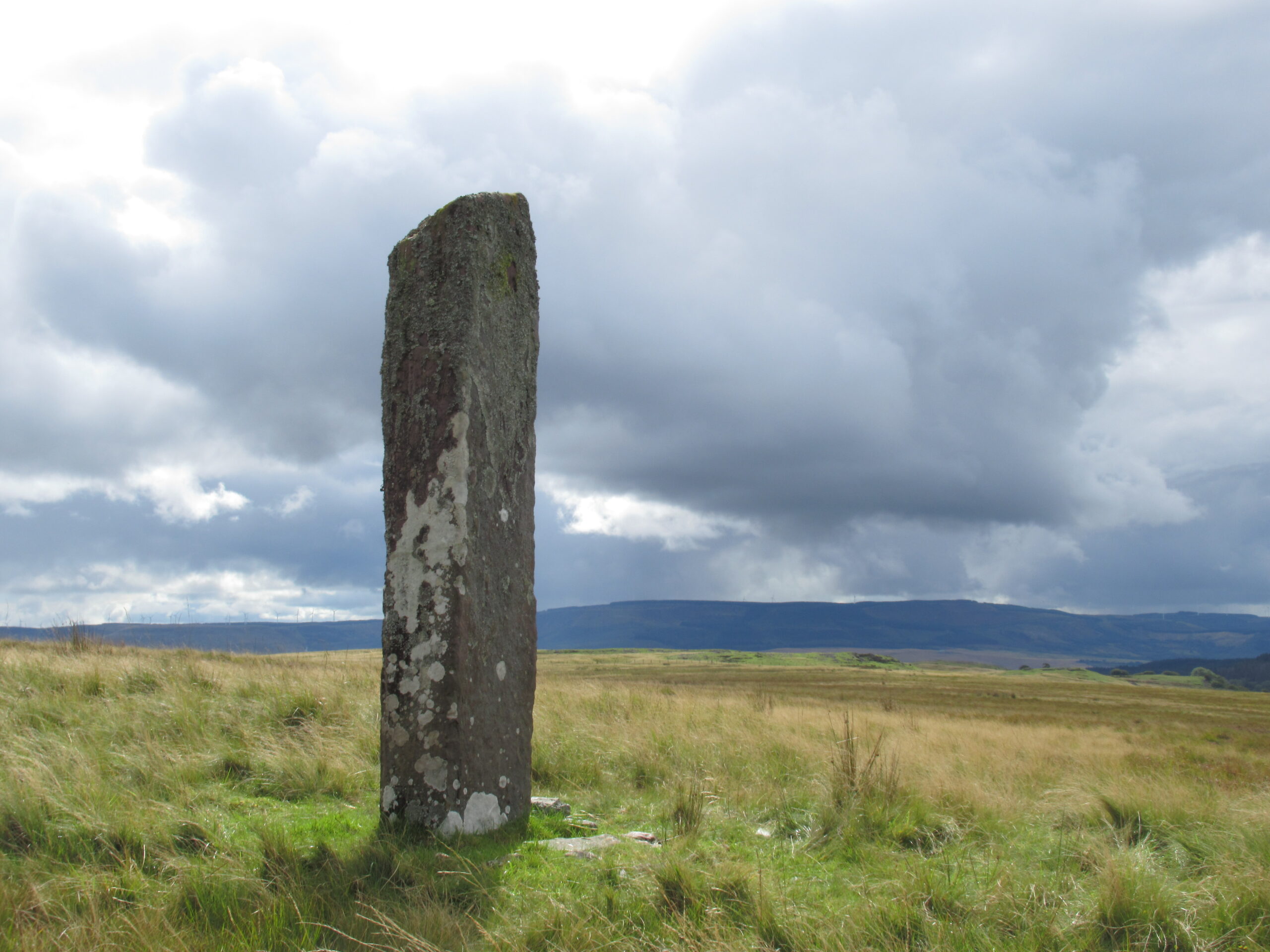
We’re on the south slope of the Fforest Fawr, north of Ystradfellte. It’s quiet and still at ground level, but above us clouds rush past from the north; some are innocent, others threaten rain. At Blaen Llia we leave the narrow road that descends Cwm Llia, and follow on foot the Roman road heading south-west. At first it doubles as a forestry track. On the left is a cut plantation, all rutted ground and shattered trunks, with a few poles left standing. To the right, blocking the wider view north to Fan Nedd, is a live forest, though it looks poorly cared for.
After an early turn the road moves ahead in a straight line. The surface has been ‘improved’ to suit heavy vehicles, with truckloads of spiky smashed stone, hard to walk on. But it’s not hard to imagine how this road might have looked in Roman times: firm foundations and a solid, dry surface, with dykes to channel water on either side. It slopes upwards towards the watershed between the two river valleys, Llia and Nedd Fechan. Towards the end of the forestry it ceases be of use to modern traffic and begins to look much more like its Roman original, as it falls quite steeply towards the sheltered green fields of the Nedd Fechan valley and the ford crossing the river.

We’re walking along one of three surviving sections of the Roman road that connected two forts, Coelbren to the south-west and Brecon Gaer to the north-east, a distance of about 23 miles. Near where we started our walk, hidden by woods, is the site of Plas-y-gors, a temporary Roman marching camp discovered from the air in the 1950s. Presumably it’s connected in some way with the road; maybe it was occupied when the road was being built or repaired.
Just after the end of the chopped forest and the beginning of open moorland, a single elegant slab of Old Red Sandstone, about 2.7m high, comes into view just to the left. This is Maen Madoc. It’s not now in its exact original position. It had fallen and was re-erected twice in the nineteenth century. In 1940 Sir Cyril Fox excavated the site and set the stone upright once again.

There’s nothing to connect the stone with the personal name Madoc, and no one knows when the name was attached to it. It should really be called the Dervacius stone, because these are the words carved in Latin, vertically, on one of the faces:
DERVAC[IUS] FILIUS IUST[I] [H]IC IACIT

That is, ‘Dervacius, son of Iustus, lies here’. Dervacius was a Briton, presumably a local notable, who lived at some time in the sixth or seventh century CE – long after Roman rule had ceased. His name appears in a Latinised form, as does that of his father, Justus, who presumably had the monument set up to mark his son’s burial place. In 1940 Cyril Fox could find to trace of Dervacius’s grave – his remains may have perished in the highly acidic soil – but he did locate what he thought was the original foundation of the stone. He also dug two trenches nearby and uncovered the Roman road intact – parallel to, but not quite on the line of the modern track. It was over 2m across and carefully laid, on a black earth and clay base, with river pebbles and boulders. Fox thought that legionaries, probably from the Second Legion at Caerleon, were responsible for building it in the first century CE.

Maen Madoc is a particularly clear example of cultural continuity through time. The conventional story goes that after the Romans ‘left’ Britain, society and economy rapidly disintegrated into a ‘dark age’, fragmented, isolated and culturally impoverished. But Dervacus and Justus, long after the last legions left, identified themselves publicly with the Roman past. They used Latin, at least for ceremonial purposes, and they followed Roman practice in setting up funerary memorials by the side of a major road. The Coelbren to Brecon Gaer road was clearly still in active use by residents and travellers when Maen Madoc was raised. The legions may have vanished, and new leaders had appeared in Wales, but the past was still part of the present.
Today the Fforest Fawr is a place to take exercise, but not to live in. In earlier times, when the climate was warmer and the landscape more wooded, many more people lived and farmed and hunted here. Continuity of occupation and cultures wasn’t confined to the transition between Roman and post-Roman times. After following the Roman road beyond Maen Madoc we turn off it to our left and climb up across moorland to stone outcrops. To the south are several round cairns, probably of Bronze Age date, and the Iron Age hillfort of Gelli Nedd – all evidence of continuous occupation of this small area over many centuries.
A rain shower drives us off the moor and we retreat to Blaen Llia. Next we travel up the valley, almost at its head, the pass where Fan Nedd meets Fan Llia, to see another testament to cultural continuity. Near the road, and visible for miles down the valley, is the stone known as Maen Llia. Cut like a diamond and 3.6m high, it’s by far the grandest of all standing stones in the Brecon Beacons. It probably dates from the Bronze Age and forms part of a group of other monuments – a cairn, an embankment and a platform – that lie nearby. Why people made the massive effort to bring it to where it is and place it upright no one can say, but we can be fairly sure about one thing: Maen Llia doesn’t stand in geographical and temporal isolation, as it seems to do today. It’s belongs to a continuous cultural flow or succession that cuts across the artificial age divisions that we like to use to carve up history.


Leave a Reply